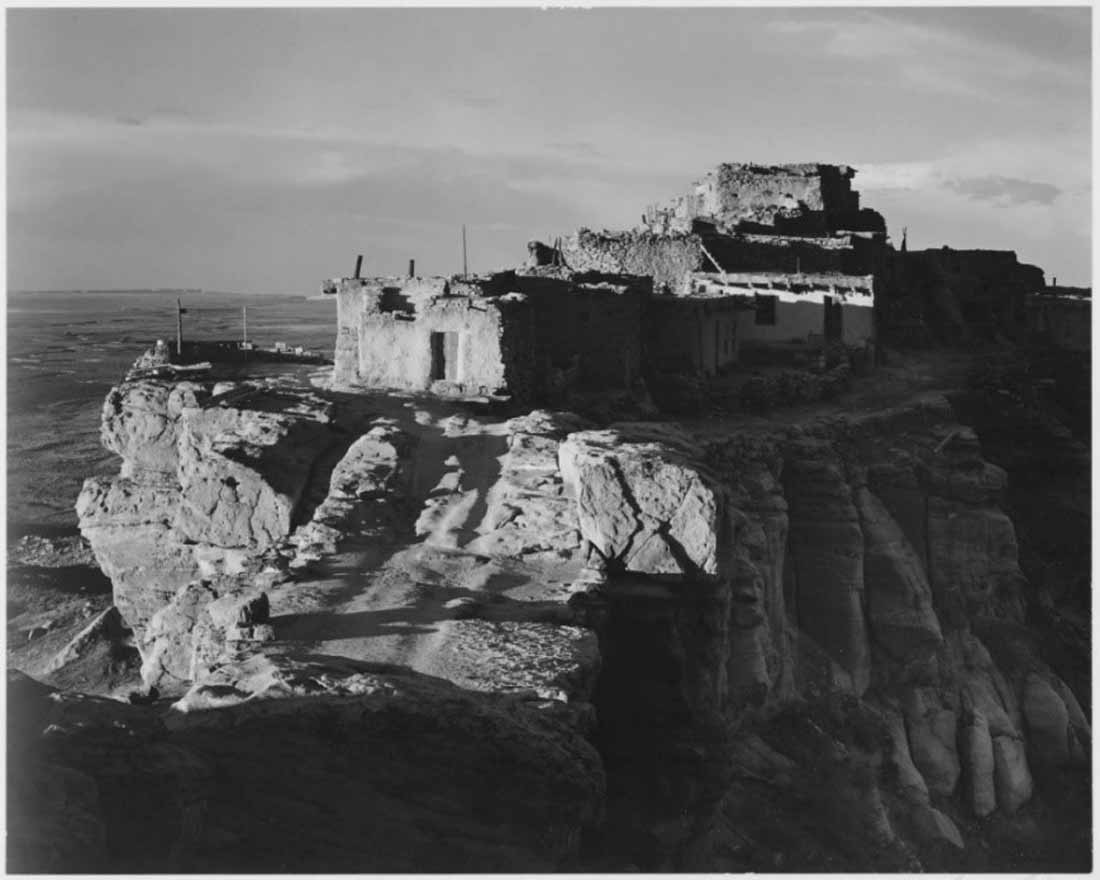By Dwight A. Weingarten
Medill Reports
Walpi and the Hopi Landscape
Traveling north nearly 300 miles from Phoenix along winding roads lies Walpi, a village inhabited for more than 1,100 years.
Walpi sits atop First Mesa and looks down from a 300-foot peak on the land of the Hopi nation that stretches across three mesas, encompassing roughly 2,500 square miles in northern Arizona.
The Hopi people, who predate the United States by thousands of years, constitute a sovereign nation recognized and protected by the United States Constitution as well as by legal precedent.
Though a sign on top of First Mesa while approaching Walpi now reads “No photographs,” the surrounding valley with its cornfields on the mesa’s south side does not look significantly different than it did in Ansel Adams’ 1941 photograph.
As people on Hopi lands, like those at Walpi, seek to maintain their traditional way of life, a fundamental rift between traditional livelihoods and the Hopi’s need to replace income from a closing power plant leaves essential tribal services hanging in the balance. While the tribal government has explored the possibility of gaming, solar and wind energy may provide a more acceptable solution.

Tradition versus Western society
“Traditionally, Hopis are considered dry farmers, relying solely on natural moisture and being able to turn around and produce the staples to provide for their families,” said Andrew Qumyintewa, the senior program director of the Hopi Foundation.
Qumyintewa, who supports the day-to-day operations of several programs, including the Natwani Coalition, which seeks to provide technical assistance to local farming projects, says “times have changed.”
There is a combination of both forms of subsistence, old and new, said Qumyintewa.
“The majority of the families still provide by farming,” he said. “But then it’s mixed with the Western society’s food intake, going to the grocery store.”
The balance of tradition with Western society influences not just subsistence on Hopi land, but economic development as well.
While other tribes have turned to gaming and casinos for revenue, historically the Hopi have strayed away, voting down gaming in 1995 and 2004 before a 2017 compact signed between the outgoing Hopi Chairman Herman Honanie and the Arizona Gov. Doug Ducey opened the door to the possibility of limited gaming on the reservation.
Andrew Gashwazra, the director of the tribe’s office of community planning and economic development, said the older generation wants no part of gaming, desiring to maintain a way of life they identify with a culture not based on material concerns.
“To those people who have never really depended on money before, they have their lives, basically tending fields, taking care of cultural obligations,” said Gashwazra. “They don’t need gaming or any of that.”
The Indian Reorganization Act and the origins Hopi government
Down a winding road from First Mesa and about 20 miles from Walpi along Arizona Highway 264 sits the Hopi capital village of Kykotsmovi, which houses the tribal council.
The 1934 Indian Reorganization Act passed by the United States Congress stipulated that in order to receive federal assistance, tribal governments would have to adopt a corporate model of governance.
Under the act, the Hopi, who had governed themselves for centuries under a village-based religious leadership system, adopted a unicameral government. This means all powers are vested in a tribal council with an elected chairman and vice chairman.
Twelve villages, including Walpi, compose the Hopi nation. However, only eight of the villages acknowledge the tribal council as their form of governance and send representatives to the 22-member council. The villages of Shungopavi, Oraibi, Hotevilla, and Lower Moenkopi are not represented on the council, according to the Hopi Nation website.
Under this system of governance, the tribe seeks to sustain itself with more than 14,000 members, only about half of whom live inside the boundaries of the reservation lands, which were dictated by an 1882 Executive Order.

Finances and the Future
The looming closure of the Navajo Generating Station, or NGS, in December brings uncertainty about the tribe’s financial future even with the possibility of gaming revenue.
Over the past 40 years, the Hopi have relied on revenues from the NGS through a coal contract with Peabody Western Coal Company, now called Peabody Energy.
The imminent closure of the NGS, brought on by increasing regulations and a movement towards renewable energy, will cut off 88 percent of the revenue that comes to the Hopi Tribe’s General Fund through the coal contract.
The general fund provides essential services to the Hopi people, including healthcare and education. Alternate sources of revenue in addition to alternate forms of energy are being proposed for the tribe.

In the 2018 Comprehensive Economic Development Strategy report prepared for the Hopi tribal council by Gashwazra’s economic development office, “Energy and Renewable Energy Development” and “Businesses such as Solar and/or Wind Development” are at the top of the list of community and economic development strategies.
The report is clear-eyed about the challenges of this transition, questioning both the reliability and viability of solar and wind as an energy and income source on Hopi land.
The report recommends an analysis of how any solar plant on Hopi land would be operated, maintained, repaired and whether there are economic benefits for the tribe from the creation of a large solar plant.
For wind energy, the possibilities are better understood.
“It must be pointed out that the return on investment in wind powered generation pales in comparison to current coal revenues,” the report states. It compares the hundreds of thousands of dollars of revenue that could be gained from a wind plant to the $13.5 million in revenue that the NGS provides annually to the Hopi.
In the Hopi Foundation in Kykotsmovi, a few buildings down from the Hopi Tribal Government Complex, Qumyintewa described the Hopi Foundation’s work of building the capacity of community organizations to self-sustaining.
The Hopi Foundation helps organizations seek education, grants, and revenue sources in order to become self-sufficient. The Hopi government as a whole faces similar issues at a larger scale, even as some of their people, such as those who live at Walpi, seek to maintain their traditional ways.
In order for the tribe as a whole to sustain itself, the tribe “definitely needs to aggressively seek resources and opportunities that will help with that,” said Qumyintewa.


